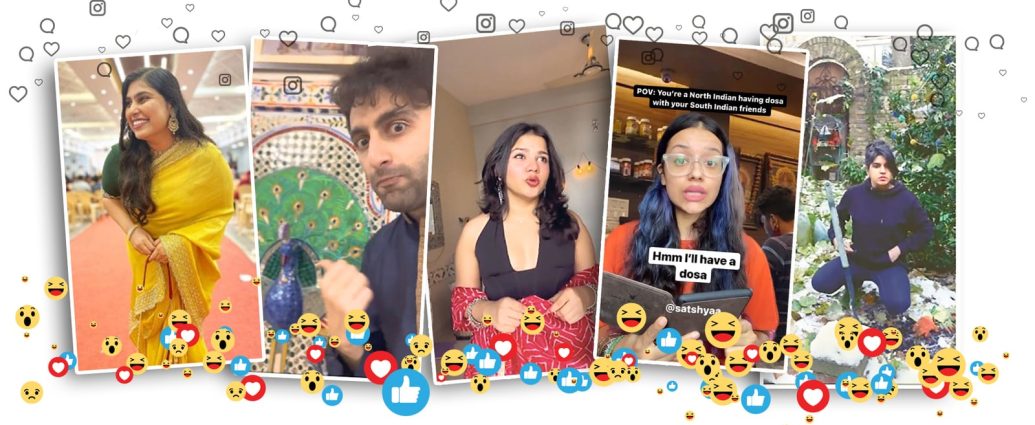We’ve all made new friends this year. For those who unwind with late-night Reels and posts online, those friends might include a hysterical young Parsi trying to learn Marathi (Zervaan Bunshah), a young Malayali with north Indian friends she loves but can’t always understand (Satshya Tharien), a Gen-Z snowflake navigating heartbreak and misadventure (Srishti Garg), a Mumbaiite constantly being taken off guard by the lyrics of Indian film songs (Sanaea Bubber).
These were some of the viral video-content creators who made us laugh in 2022, as we struggled, each in our own way, to limp back into a new normal. Through their satire, parody and good-natured jokes at their own expense, they spotlit problematic aspects of how we think and behave, encouraged us to learn more about each other, be kinder to one another and ourselves. They also served as archivists of who we are, and who we are becoming.
Garg, 21, from Jodhpur says a big part of her mission is drawing humour from imagining what today’s Gen-Z-ers will be like as adults, employees, teachers, daughters-in-law, mothers. “Content should offer a unique perspective and document some aspect of how the world is changing. It should feel like something you have in your head but couldn’t put into words. It is that brief moment that I aim to recognise and seize,” she says.
“I’m always making fun of myself or the rich and elite,” adds Bunshah, 29. In his videos, he leans into the truest stereotypes about his beloved community, turning single words into Parsiisms (Moooovvvve!!!), reciting Marathi poetry in character and then trying to decode it, and reacting with both panic and mild annoyance when a wedding guest fractures a finger.
The scenes are short, the sets sparse. The storylines look simple but look closer and the effort at balancing nuance, commentary, humour and kindness are evident.
Tharien, 28, has tens of thousands laughing along to Reels in which she pokes gentle fun at elements of south and north Indian culture. There are posts on Mangalore Kannada vs Bangalore Kannada, Malayalam-speakers struggling with Hindi-speaking neighbours, and what to do when you’ve texted your boss saying their newborn is an absolute kutta, because in Malayalam that means cute.
“Culture is a delicate subject. Jokes crafted improperly may seem offensive,” Tharien says. “But if you can make people laugh while teaching them something new, that’s a win-win. And yes, we’re all different, but instead of arguing about who is better, let’s all learn about each other’s quirks and have a good laugh about it.”
Take a look at some of the comedic video content that made us laugh hardest this year. There are bits in Hindi, Malayalam, Kannada, Dakhini, Punjabi, Tamil, Marathi, Gujarati and English. And special videos crafted for Wknd, and performed in character. Happy watching. And happy new year.
A mugging turns into What’s in My Bag
Srishti Garg, a 21-year-old content creator in her final semester at the National Institute of Fashion Technology in Jodhpur, has collected over 200,000 followers with posts that focus exclusively on “Gen-Z speak”.
Her Instagram account is a gentle takedown of the snowflake generation, with its self-indulgences and ideas of the self as celebrity. A big part of her mission is drawing humour from imagining what today’s teen girls will be like as adults, employees, daughters-in-law, mothers.
In one case, what they’d be like as kidnapping victims. In this one, she starts out angry at the kidnapper’s tone. Then asks if she can upload a video of this experience with, since it’s winter, “full cozy vibes”. As the kidnapper asks for valuables, this becomes an episode of What’s in My Bag (with some subtle product placement woven in). Reminded that this is a kidnapping, she thanks him for the timely trigger warning.
In the background, bulbs on a chord mimic fairy lights, a faux-antique mirror frame sits to one side. She is dressed in shades of lemon and mauve.
Garg says she carefully picks out and mimics the ideas, language, and behaviours that define her generation, imagining or drawing from real conversations, with the kind of matter-of-fact delivery one can overhear at a nightclub anywhere in the country. Most of her posts are in Hindi.
In one clip, she insists she will only enter her wedding to the tunes of the song I’m a Gangster’s Wife, and explains to a concerned mother-in-law-to-be that this isn’t a reflection on her son. It’s just that “Mera aaj-kal dark-feminine-aesthetic chal raha hai”.
Most of her fans are Gen-Z-ers too (the term for the successors to the millennials; those born between 1997 and 2012). “I’ve realised that perhaps Gen-Z is like that; our generation is direct with others. My first video, which featured Gen-Z as teachers, received one million views.” Many of Garg’s Reels have over 100,000 views; some have over 5 million. She thinks the videos do so well because they offer a mix of “something new and something familiar”, she says.
“Content shouldn’t only be relatable. It should also offer a unique perspective and document some aspects of how the world is changing. It should feel like something you have in your head but couldn’t put into words. It is that brief moment that you must recognise and seize.”
How does one ensure that an idea is a million-views-funny? “You can never be sure,” says Garg, “but after that first video, in June 2022, the videos took off. In a month I went from having 50,000 followers to having 100,000.”
Saturation can set in, she admits. So she’s always looking for new material, new themes. “I want to keep doing stuff that nobody has ever seen before,” Garg says. “Maybe different types of comedy too.”
Did you really just say that?
Satshya Tharien, 28, has built her following of 258,000 off the idea that we’re all willing to laugh a little harder at ourselves. The Malayali journalist-turned-content-creator was born in Tamil Nadu, raised in Mangaluru and now lives in Singapore. It all started, she says, because as a teen she couldn’t relate to the mainstream stand-up acts coming out of Mumbai and Delhi. “Now we’re at the stage where we see our culture and quirks being represented by so many regional creators on the internet, and that’s really refreshing and heartwarming,” Tharien says.
In her videos, elements of the north and south both feature, with the differences highlighted with humour. In one video that’s had over 5.5 million views, a north Indian wants to order a dosa, and is told by three south Indian friends that she is saying it wrong, except each friend speaks a different south Indian language and wants her to say it a different way — dosai, dosha, dose, dosa. Eventually, they all agree on one thing: “It’s not sambhar. It’s saambaarr!”
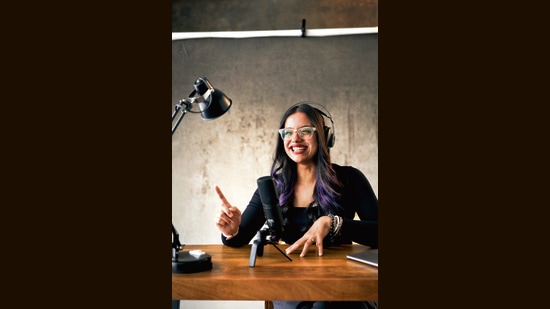
On Tharien’s Instagram page, there are also Reels on Mangalore Kannada vs Bangalore Kannada, Malayalam-speakers struggling with Hindi. There are plays on similarities and differences. Does kutta mean “dog” or “cute”, and what do you do when you’ve already texted your boss saying that’s what their newborn is? In one endearing Reel, it’s a north-south arm-wrestle, until both halves of the country realise that somehow they always seem to have an aunt around named Baby.
“Culture is a delicate subject. Jokes crafted improperly may seem offensive,” Tharien says. “But most of my video ideas come from my own experiences, from those “Oh noooooo!” moments I’ve had while interacting with people from different parts of India. A lot of people seem to relate to that.”
Meanwhile, tucked away even in something simple like the dosa / dosai Reel is the gentle reminder that south India isn’t a homogenous block. Given how carefully she researches her use of languages that are not her own, she hopes that people might actually learn from her Reels, even if it’s just a few common words from a different tongue.
“We want to be entertained but we also want to feel like we’re getting some value out of our time spent on social media. So if you can make people laugh while teaching them something new, that’s a win-win,” Tharien says. “Yes, we’re all different, but instead of arguing about who is better, let’s all learn about each other’s quirks and have a good laugh about it, together.”
A Parsi guy walks into a bar…
When Zervaan Bunshah began posting Reels in 2021, he wanted to use Instagram to further a career in singing and acting. He stumbled into comedy by accident this August, after a video on how Parsis speak Marathi went semi-viral, with over 500,000 views.
Perhaps the funniest things about Bunshah, 29, are the very Parsi accents, and the near-hysteria with which his young Instagram persona approaches everything from a new Hindi phrase to a wedding guest who’s fractured a finger. There’s also the way he can turn a single word into a Parsiism (Moooovvvve!!!), recites Marathi poetry in character and then tries to decode it, and the way he gets worked up about politics, pesky relatives, Bombay Iranis and a lot else.
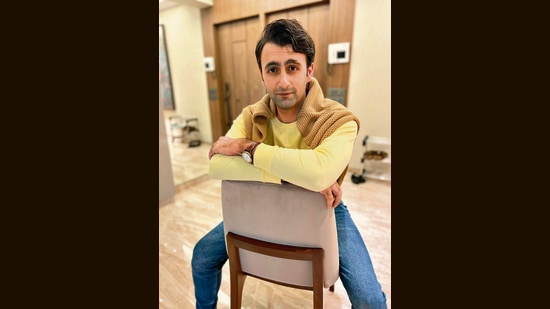
For a long time, he avoided leaning into this stereotype, Bunshah says, believing it was just low-hanging fruit. With that first Marathi-speaking video, he realised he was onto something. Unlike the tired tropes of the cranky old Bawa or the unintentionally funny bumbling Bawi, he’s laughing at himself (and other upper-class Parsis) in a new idiom. The content draws on brunches, hook-ups, socialite clichés and activist chit-chat.
It’s authentic, current, well-written and impeccably performed; almost like peering through the windows of a Parsi home, or listening in at a Mumbai café. “It often is overheard conversation, so I don’t have to try too hard to make it funny,” Bunshah says, laughing.
This has also now become a way to document the eccentricities and much-loved quirks of a fast-fading community (India’s Parsi population has declined from 1.14 lakh in 1941 to about 50,000 as of the 2011 census.)
Bunshah’s girlfriend, a doctor from Mumbai currently studying in Germany (she wished to remain unnamed), pitches in with scripts and characters. “It was she who asked me to embrace the Parsi stereotype and I’m glad I took her advice,” Bunshah says. “She told me, ‘Don’t be afraid to own who you are; don’t be apologetic about it’.”
“As they say,” he concludes, now in character, “laugh at yourself and the world laughs with you!”
Have you been singing it wrong?
There have been some crazy ideas in Bollywood songs. In the song Chittiyaan Kalaiyaan from the 2015 film Roy (Ranbir Kapoor, Arjun Rampal), for instance, the key refrain is a woman singing with joy because her wrists are so very fair. This is a song that became a massive hit, and remains popular.
Sanaea Bubber’s Instagram series, Literally Translating Indian Songs, is a smorgasbord of such examples. The 28-year-old who currently lives in the UK grew up in Mumbai, listening to Bollywood songs and being largely unaware of what they meant. Earlier this year she discovered a TikTok video by comedian and musician Anesti Danelis, about a Disney song filled with innuendo. It reminded Bubber of how she and her mother would sometimes translate Bollywood songs into English in their living room and laugh at the silliness of some of the lines. Bubber decided to build on this.
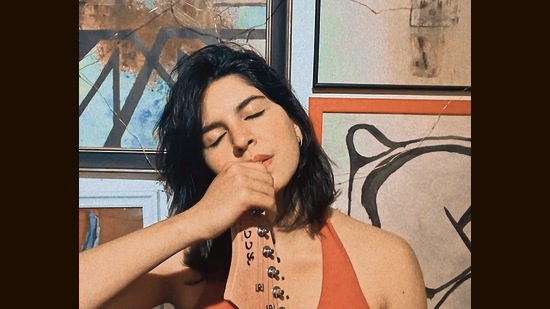
“This is a concern — the lack of consent, the crass language and over-sexualisation of women by and for the male gaze,” she says. “When I make videos now, I’m driven by a different intention. It’s troubling that I have such a wide variety of problematic tunes to choose from. This is important.”
Since her first few videos in this series went viral this year, she now has nearly 200,000 followers across Instagram, YouTube and TikTok. “I was at a very low point in my life when I began this series. I had just got a rejection letter for my PhD that I had applied to. I felt I had absolutely no direction and purpose,” she says. “So what does one do when they feel lost? Listen to some Bollywood, of course.”
Most of the feedback she receives revolves around how funny her “reactions” to the lyrics are. “I make it a point to be melodramatic each time,” she says. From putting her laptop in the oven to brushing her hair with a toilet brush and “drinking” dishwashing liquid, the majority of the videos consist of her moving around the house and performing tasks incorrectly in response to the distractingly disturbing lyrics.
Bubber’s original dream was to be a musician. She’s a jazz and contemporary vocalist whose songs are available on music-streaming platforms. “I never imagined that my comedy skits and bits would steer my content in a completely different direction,”’ she says. “I like combining the two frequently. In a perfect world, I’d like to make people laugh at my humour and cry with the pathos of my songs.”
The rapid-fire round
Chennai-based Zoha Sanofer, 27, is promoting her mother tongue, Dakhini, in an unusual way. Her Instagram account consists of videos of her speaking in Dakhini, in the persona of a pesky “Aunty”, with a young woman (also her) pushing back.
The videos spotlight, with humour, issues such as the double standards women apply to their daughters and daughters-in-law; elders’ unsolicited advice on marriage, parenthood and parenting; and emotional blackmail of the kind familiar to young people across the subcontinent (“It’s your life; it’s up to you.”)
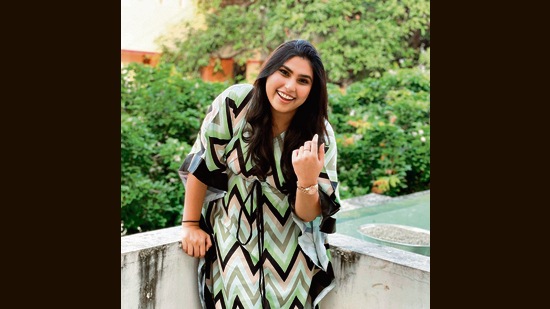
“Every video I’ve made is about a situation I’ve been in or heard of or from conversations I’ve had with my mother,” Sanofer says. She has created more than 500 videos since July 2021. She now has 138,000 followers on Instagram, with some of her videos gathering over a million views.
Dakhini is a language of the Deccan that draws from Urdu and Hindustani and is spoken in pockets of Andhra Pradesh, Telangana and Tamil Nadu. Sanofer began creating content to promote the language, she says, after years of being too shy to speak it outside her home, because of what she describes as its rustic sound.
Non-Dakhini speakers may not fully understand every message (not all videos are subtitled), but many of the words bear similarities to Hindi, so the message is usually clear to people familiar with that language.
Sanofer got married six months ago and, laughing, says she’s had a lot of new experiences to draw from. “No matter how progressive your immediate family is, there will be relatives or people who are self-appointed custodians of ‘tradition’.”
There are critics, of course, online and offline. While a lot of her viewers pop up in the comments sections to say they can relate, some are aggressive and critical. “Why don’t you wear a hijab or first cover your hair and then come and talk?” said one comment. “There’s also a lot of fat shaming. It used to bother me, but not so much anymore,” Sanofer adds.
The highlight of her journey, however, has been how her videos have spread on WhatsApp. “It felt like a real achievement when one video landed in my father’s inbox as a forward.”
Her parents understand the depth of the message she is trying to convey, to girls in particular, Sanofer adds. “They appear to be a little proud, or so I’d like to believe,” she says, laughing.
This winter season, get Flat 20% Off on Annual Subscription Plans
Enjoy Unlimited Digital Access with HT Premium

